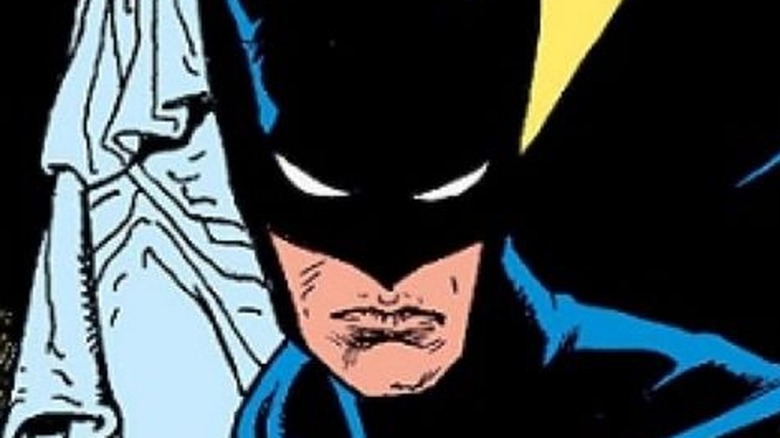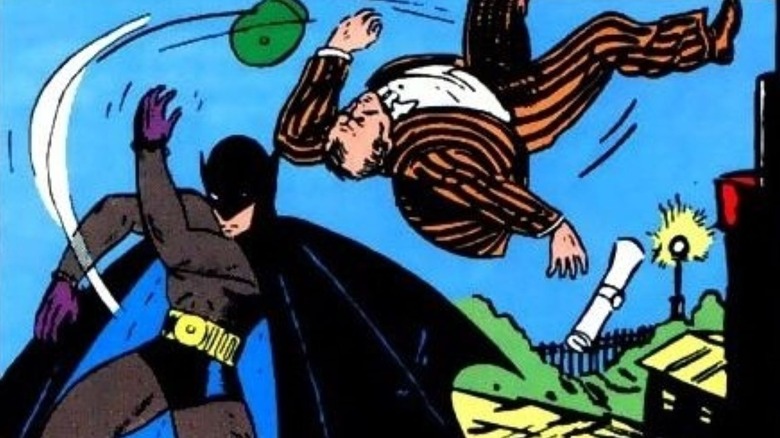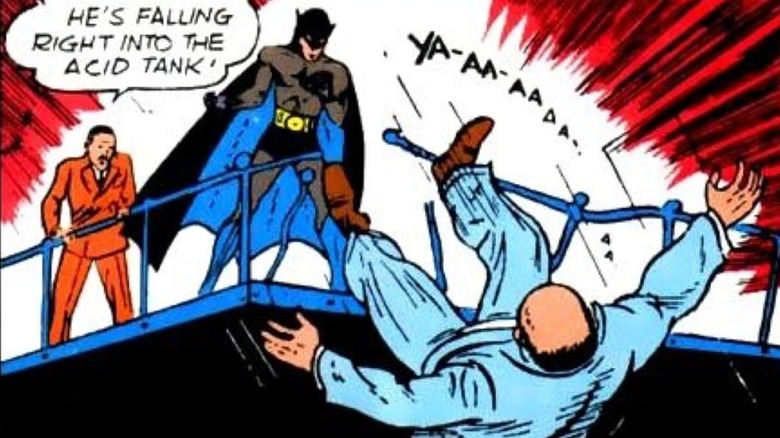The Detective Comics Batman Moment That Didn't Age Well
Bruce Wayne donned the cape and cowl to protect his beloved Gotham City nearly a century ago. Since then, he has grown into one of the most popular superheroes the world has ever seen. But he didn't do so without bumps along the way. While he is known for his no-killing rule, that doesn't mean he has always believed that. He has terrorized, tortured, and even killed people in the past, proving that he is anything but the heroic beacon of light he is meant to be in so many adaptations.
In "Batman #1" (1940), Batman committed his first emotionless killing. As he was pit against 15-foot-tall giants that used to be inmates at an insane asylum, he showed just how ruthless he could be. As Hugo Strange gave the inmates a serum to make them mindless giants and have them wreak havoc on the streets of Gotham, Batman tricks two of them into beating each other to death. He hangs one of them from a noose dangling from his Batwing and kicks Hugo Strange off a cliff into the waters below. All of this in his first solo comic appearance!
Since then, he adopted a no-killing rule and became more focused on his morals and tactics. While he still terrorizes those bad people that prey on his city, he does so with more toned-down methods, electing to draw the line at torture (I mean, why wouldn't you?). The truth is most comic book heroes find themselves in situations where they have to make impossible choices. Some feel they have no choice but to take a life and therefore are tortured by the prospect. However, Batman did more than just kill early on; he did so coldly, and with zero regrets. Here is the moment from Batman's early years on Detective Comics that didn't age well.
He killed the villain in his very first appearance
Bruce Wayne/Batman's debut happened in Detective Comics #27 (Volume 1). It hit the shelves on March 30, 1939, and contained readers' first glimpse of the man they would come to know as The Dark Knight. While he would grow to become one of the most recognizable superhero brands across the planet, his droves of fans would barely recognize the brutal and cold man portrayed in the short storyline.
The story opens with Commissioner Gordon entertaining his young friend, socialite Bruce Wayne, in his home. He comments that Wayne must lead a very boring life as he seems disinterested in everything. Although Wayne asks him if anything interesting has transpired lately, Gordon remarks that Bat-Man (as he was then referred to) has puzzled him recently. Soon after, Gordon is called to the murder of a chemical manufacturer named Lambert, and he takes Wayne with him — was it normal for police to take the wealthy elites to crime scenes to satisfy boredom back then?
The police suspect the victim's son, who says he pulled the knife from his father's back when he found him and witnessed a figure climb out the window. The younger Lambert says his father's last word was "contract." He tells the police that his father had just entered into a contract with Alfred Stryker, Paul Rogers, and Steven Crane. Lambert and Crane had received death threats, and the latter is eventually murdered as well. While Gordon went to see Crane, Bruce Wayne returned home for just long enough to put on the Batsuit and catch Crane's killers on the roof of his building. He knocks one out and then throws the other off the top of the two-story building. While callously dropping someone from 30 feet up is bad enough, that was just the second-worst thing Batman did in his debut.
Batman showed no remorse for killing the bad guys
After tossing a villain off the roof, Batman discovers that the last two contract signers are meeting in Stryker's laboratory. Stryker attempts to kill Rogers, but Batman intervenes. When Stryker pulls a gun to shoot them both, Batman punches him so hard that he breaks through a metal railing, falling into a vat of acid. When Rogers exclaims that he is falling into the acid tank, Batman callously comments that it is a "fitting end to his kind." Later, when Gordon tells the story to his wealthy friend, Bruce Wayne, Wayne says it is a "lovely fairy tale."
While the man was a murderer and Batman was protecting a businessman from being killed, his disregard for life and the emotionless retort, when questioned about it, displayed a devilish Dark Knight that would be more akin to the kind of villain Batman would try to stop today. It is this kind of behavior that Batman tirelessly tries to prevent his Robins (namely Jason Todd and Damian Wayne) from engaging in. His psychology on killing has developed over the century, becoming the main focus on his insistence that he won't kill Joker, even if doing so will ultimately protect people. His no-killing rule even inspired a book that discusses it further. And with that in mind, Batman's cold-blooded murder of one (maybe two?) villains in his very first appearance doesn't hold up to the rest of the story of the Dark Knight.


